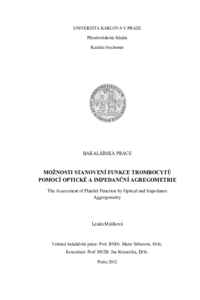Možnosti stanovení funkce trombocytů pomocí optické a impedanční agregometrie
The assesment of trombocyte function by optical and impendance agregometry
bakalářská práce (OBHÁJENO)

Zobrazit/
Trvalý odkaz
http://hdl.handle.net/20.500.11956/43111Identifikátory
SIS: 116705
Kolekce
- Kvalifikační práce [19613]
Autor
Vedoucí práce
Konzultant práce
Kvasnička, Jan
Oponent práce
Poljaková, Jitka
Fakulta / součást
Přírodovědecká fakulta
Obor
Biochemie
Katedra / ústav / klinika
Katedra biochemie
Datum obhajoby
11. 9. 2012
Nakladatel
Univerzita Karlova, Přírodovědecká fakultaJazyk
Čeština
Známka
Velmi dobře
Klíčová slova (česky)
krevní destičky - trombocyty, agregace, ASA, clopidogrel, agonisté - induktoryKlíčová slova (anglicky)
platelets - trombocytes, aggregation, ASA, clopidogrel, agonists - inductorsÚvod: Krevní destičky hrají klíčovou roli v procesu zástavy krvácení tvorbou primární destičkové hemostatické zátky. Za určitých okolností je však tato role krevních destiček nežádoucí a podáváním lékových preparátů kyseliny acetylsalicylové (ASA) a clopidogrelu je záměrně zasahováno do mechanismu primární hemostasy a funkce destiček je potlačována nebo zmírňována. Tento proces však musí být řízený a dobře kontrolovatelný. Clopidogrel je antiagregační lék úspěšně používaný k prevenci trombotických komplikací. Aktivní metabolit vzniká z clopidogrelu in-vivo účinkem cytochromu P450 3A4 a váže se selektivně a ireversibilně na receptor P2Y12, čímž blokuje aktivaci destiček prostřednictvím ADP. Účinek clopidogrelu je značně variabilní. Je známo, že neodpovídavost na léčbu se objevuje u 5- 30 % pacientů. ASA ireversibilně acetyluje destičkovou cyklooxygenasu (COX), čímž blokuje přeměnu arachidonové kyseliny (AA) na tromboxan A2 (TXA2), a zabraňuje tak aktivaci destiček. Léčba aspirinem je efektivní, avšak u některých pacientů se vyskytuje tzv. aspirinová resistence (AR), tedy neodpovídavost na léčbu ASA. Cíl studie: V naší práci jsme se zaměřili na stanovení referenčních rozmezí pomocí měření funkce krevních destiček u zdravých dárců. Dalším cílem bylo stanovit účinnost clopidogrelu a ASA dostupnými...
Introduction: Platelets have an important role in the process of haemostasis in which they form blood clot generation. In some cases it is necessary to suppress activity of platelets by antiplatelet drugs to prevent life threatening states. Acetylsalicylic acid (ASA) and clopidogrel can influence the mechanism of primary haemostasis by inhibition of platelet function. This process has to be controlled. Clopidogrel is used for prevention of thrombotic states. The active form of clopidogrel is formed by cytochrome P450 3A4. Clopidogrel binds to the receptor P2Y12 instead of ADP, so platelets cannot be activated. The effect of clopidogrel is very variable. It is known that there is unresponsiveness to clopidogrel in 5-30 % patients. Acetylsalicylic acid acetylates cyclooxygenase and blocks the conversion of arachidonic acid to tromboxan A2, so platelets cannot be activated. ASA treatment is effective, but in some patients can appear so called aspirin resistance (AR). Possible unresponsiveness to the therapy is the reason why it is suitable to monitor antiplatelet therapy, which may be provided by various methods. Thesis target: To detect normal range in measurement of healthy control group, evaluate efficiency of clopidogrel and ASA and to determine which method (LTA - Light Transmission Aggregometry...
